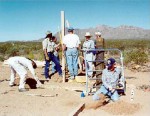Jornada Basin LTER Site
Plans to create a focus for the SLTER program, as well as for the thousands of children who tour the Jornada Basin LTER site each year have been long in the making. A recent turn of events has boosted the development on this project.
It all began on June 2, 2000. During a routine road grading, a Doña Ana County employee accidentally struck a buried pipeline, spraying more than 74,000 gallons of diesel fuel onto the Jornada Basin LTER site at the future location of the Chihuahuan Desert Nature Park (CDNP).
Chevron responded rapidly to the initial spill, removing much of the pooled diesel, while county employees built a berm to prevent diesel from flowing onto Jornada Road. Chevron employees also replaced the broken section of pipe, lowered a large section of the line deeper underground, and then covered the line. Soon after, county employees removed the affected soil and spread it along Jornada Road to allow for evaporation of the diesel. By that time, diesel had already penetrated to up to 14 feet in depth. After the diesel evaporated, treated soil was placed back in the original road or spread along Jornada Road. Chevron and Doña Ana County continue to discuss who will pay for clean up.
Most of the diesel was confined to the area of the Nature Park near the road. However, clean up efforts resulted in a new access road south of the original road, a large bare area where the pipeline was lowered, and a parking area southeast of the spill.
Through the interactions surrounding the spill, Chevron learned about the plans for the Chihuahuan Desert Nature Park. In turn, director Stephanie Bestlemeyer learned about the emphasis Chevron places on K-12 science education through their corporate giving program.
The spill also reinforces the importance of the CDNP's mission to help a growing population live successfully and sustainably in the Chihuahuan Desert, Stephanie says.
Site Development Begins
After many years of planning and with the assistance of many dedicated volunteers, the CDNP site development is underway.
The first day of labor yielded the installation of signs and of demonstration plots. The demonstration experiment focuses on some of the methods used by scientists at JRN to reestablish native grasses on areas that have been disturbed. The plots will serve three purposes:
- Revegetating a large area that was damaged during the cleanup of the diesel pipeline spill
- Educating students about the scientific process and the unique aspects of working in deserts
- Establishing a presence for the Nature Park on the site.
The experiment was designed by Nature Park Board member Mary Beth Harper, Jornada Experimental Range scientist Jeff Herrick, and Nature Park director Stephanie Bestelmeyer. Some plots serve as controls, while others have combinations of four different treatments: seed addition, fertilizer addition, tillage, and chicken wire installation to exclude herbivores.
Much of the funding for the project is being provided by Chevron.
"We've been able to turn a negative situation into a positive way to extend our mission of increasing scientific literacy and fostering an understanding of the Chihuahuan Desert," Stephanie says.
Original development of the Nature Park was outlined in a Master Planning process in 1996. The Park is seeking funding for additional development, including the installation of nature trails, interpretive signs, an outdoor amphitheater, visitor facilities, and exhibits featuring Chihuahuan Desert plants and animals.
Volunteer turnout for Site Development Day reflected the tremendous community support for the Chihuahuan Desert Nature Park's programs. Boy Scout Troop 179 was especially helpful in all phases of the project, and several troop members have expressed interest in carrying out their Eagle Scout projects at the Nature Park.
Supplies for the project and refreshments for the volunteers w ere provided by the Chevron Pipe Line Company. Considerable technical support in designing the experiment was received from the USDA/ARS Jornada Experimental Range. Bright Star Dairy donated the fertilizer for the project.
Phase II will include the installation of permanent signs explaining the experiment. Future phases include the installation of hiking trails, interpretive signs, an amphitheater and visitor facilities on the Nature Park site.
These news items originally appeared in Jornada Trails, newsletter of the Jornada Basin LTER site, Online at http://jornada.nmsu.edu/

 Enlarge this image
Enlarge this image
